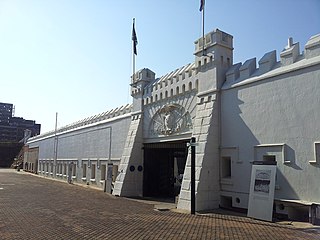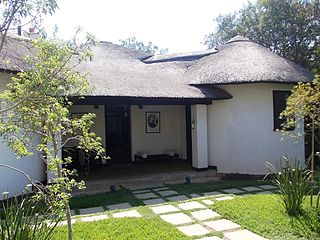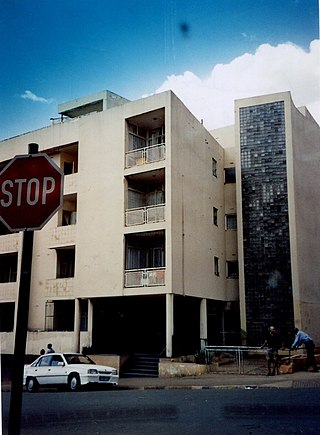
Gauteng is one of the nine provinces of South Africa. The name in Sotho-Tswana languages means 'place of gold'.
Midrand is a former municipality in central Gauteng, South Africa. It is situated in-between Centurion and Sandton and now forms part of the City of Johannesburg Metropolitan Municipality.

The Constitution Hill precinct is located at 11 Kotze Street in Braamfontein, Johannesburg near the western end of the suburb of Hillbrow. Constitution Hill is the seat of the Constitutional Court of South Africa.
Moodie Hill is a small affluent suburb consisting of four roads; Springhill Road, Springhill Close, Van Meurs Avenue and a small section of Coleraine Drive. It is situated in Johannesburg, Region E of the City of Johannesburg Metropolitan Municipality, Sandton. South Africa.
Saxonwold is an affluent suburb of Johannesburg, South Africa. It is situated in what was once the Sachsenwald Forest in the early 20th century. It is located in Region E of the City of Johannesburg Metropolitan Municipality.

Castle Kyalami is a castle located in Kyalami in the province of Gauteng, north of Johannesburg, South Africa. Formerly a tourist attraction and hotel, the castle was purchased by the Church of Scientology in March 2008.

The mansions of Parktown are an important part of the history of the city of Johannesburg. They were the homes of the Randlords, accountants, military personnel and other influential residents of early Johannesburg, dating back as early as the 1890s. The first of these mansions, Hohenheim was designed by Frank Emley and was built for Sir Lionel Phillips and his wife Lady Florence Phillips. The name Hohenheim had been used originally by Hermann Eckstein, one of the first Rand Lords to name his house after the place of his own birth. When Phillips became the head of Eckstein & Co, he moved in to Eckstein's house but due to the expansion of the city decided to build the new Hohenheim in an enviable site further from the mine workings. Sir Lionel Phillips was banished from the Republic for his involvement in the Jameson Raid. It is perhaps fitting that the next occupant of this famous house was none other than Sir Percy Fitzpatrick, the author of the best selling book 'Jock of the Bushveldt'. The house was demolished but a plaque remains in honor of this building.

Muldersdrift, in the Gauteng Province of South Africa, is a picturesque rural area situated 27 km north-west of the CBD of Johannesburg, between Johannesburg and the Magaliesberg mountain range. The area falls under the West Rand District Municipality, and is part of Mogale City.

Satyagraha House, commonly known as Gandhi House, is a museum and guest house located in Johannesburg. The house belonged to Mahatma Gandhi: he lived and worked there between 1908 and 1909. It is registered as part of Johannesburg's historical heritage. Satyagraha means insistence on truth. The house was designed by the architect Hermann Kallenbach for Gandhi and himself.

Johannesburg City Hall is an Edwardian building constructed in 1914 by the Hawkey and McKinley construction company. The plan for the building was drawn in 1910 and construction was started in 1913 and finished in 1914. The Gauteng Provincial Legislature currently occupies the building. The City Hall has seen many political events on its steps from protest meetings to a bomb blast in 1988.

Manners Mansions was designed by the architectural firm of Emley and Williamson for African City Property Trust and was built in 1937-1939. The building is situated on stand 5198, at the corner of Jeppe and Joubert Streets in Johannesburg.

The Rand Water Board was established in 1903, tasked with supplying the water needed to support mining activities and sanitary living conditions for those living in the developing urban area of Johannesburg.

The Beacon Royal, also known as the Beacon Court, is an Art Deco block of flats constructed in 1934. This was a time of enormous growth as South Africa and the rest of the world emerged from the Great Depression. All over Yeoville and Bellevue in the years 1933 – 1934, blocks of flats were going up. The Beacon Court is located on stand 1044 at 55 Grafton Road/Louis Botha Avenue in Yeoville, Johannesburg. It was designed for PP Weisholtz by the brothers Obel and Obel who were also responsible for Astor Mansions in Jeppe Street and the Circle Court in Willie Street which overlooked Clarendon Circle at the time.

House Hains is an historic residence in the Yeoville section of Johannesburg, South Africa.

Radoma Court was designed in 1937 by the Harold Le Roith practice of architects. It is situated prominently on a corner site in Bellevue, at stand 474 where Cavendish and Yeo Streets meet.
Endstead is an historic house in Parktown, Johannesburg, South Africa built in 1903 by Ernest Willmot Sloper for his own use.
Alexander Jeremiah Orenstein was a Russian-born naturalized American general and military doctor.
Denver is an industrial suburb in eastern Johannesburg, South Africa, on the railway to Germiston and Hoofrif Road, around 6 km east of City Hall. It borders Benrose to the west, Jeppestown and Malvern to the north, Cleveland to the east, and the François Oberholzer Freeway to the south. Just a small portion of the suburb in the northwest has residential zoning; otherwise, Denver consists of industrial land and squatter camps both in the west and up north, the latter largely on Hoofrif Road.

Joseph Moses Gerald Gordon was a prominent South African architect, Professor (1976–1994) at the University of Witwatersrand School of Architecture, and Honorary Research Fellow of the university (1994-2016). He is best known for inventing the "Thin-Skin" building method. His papers and drawings are archived at the University of the Witwatersrand School of Architecture & Planning. He was president of the Transvaal Institute of Architects in 1978 and 1979. His residential home was commemorated with a "Blue Plaque" by the Johannesburg Heritage Foundation in 2021.












